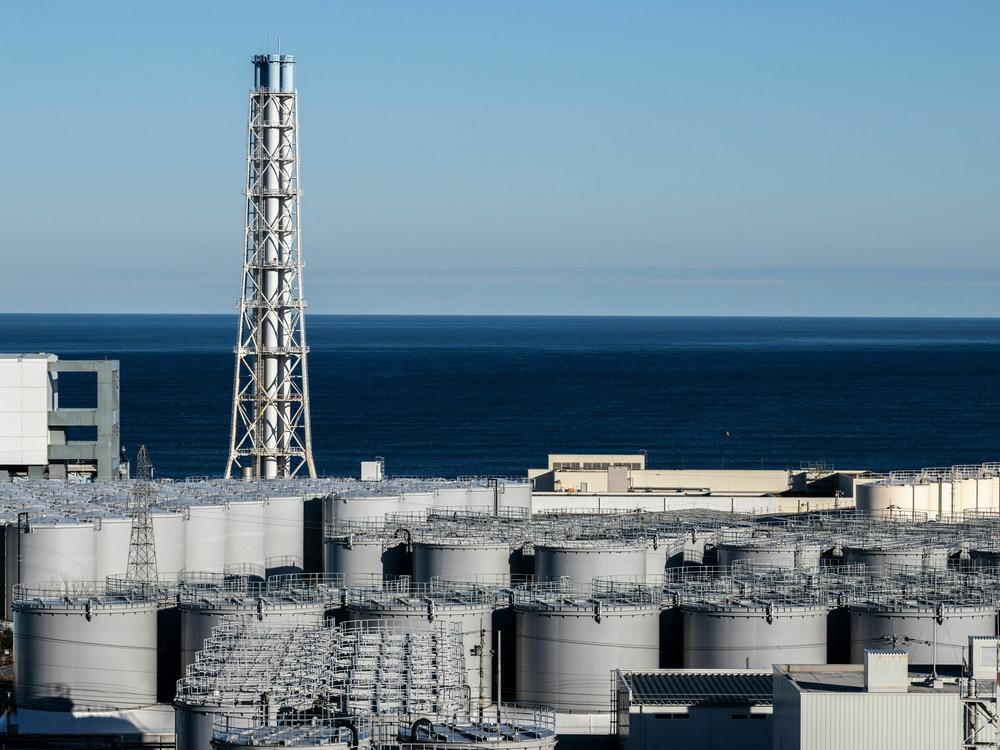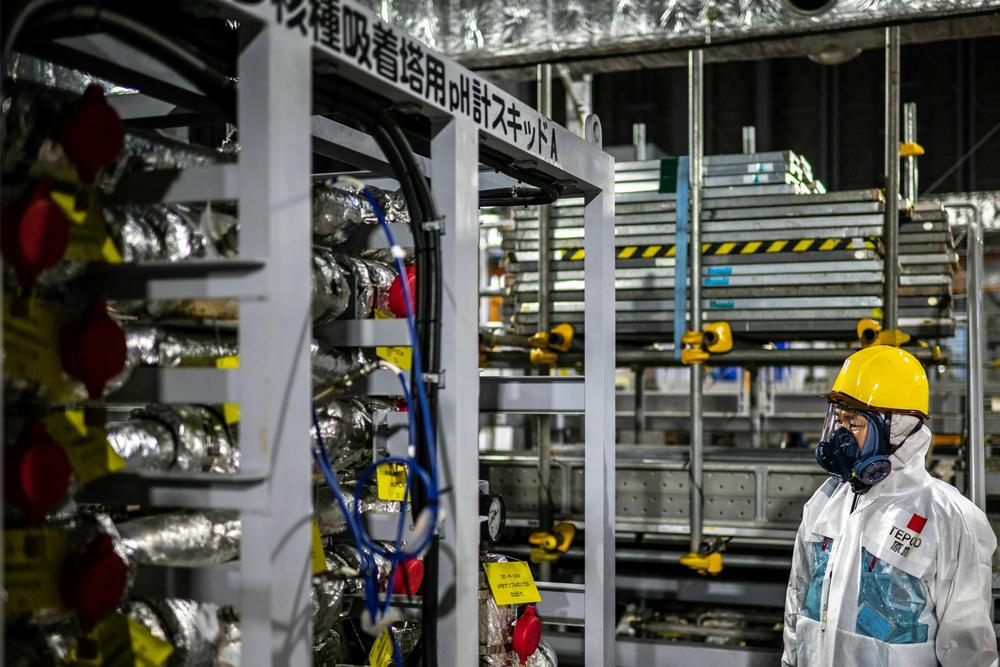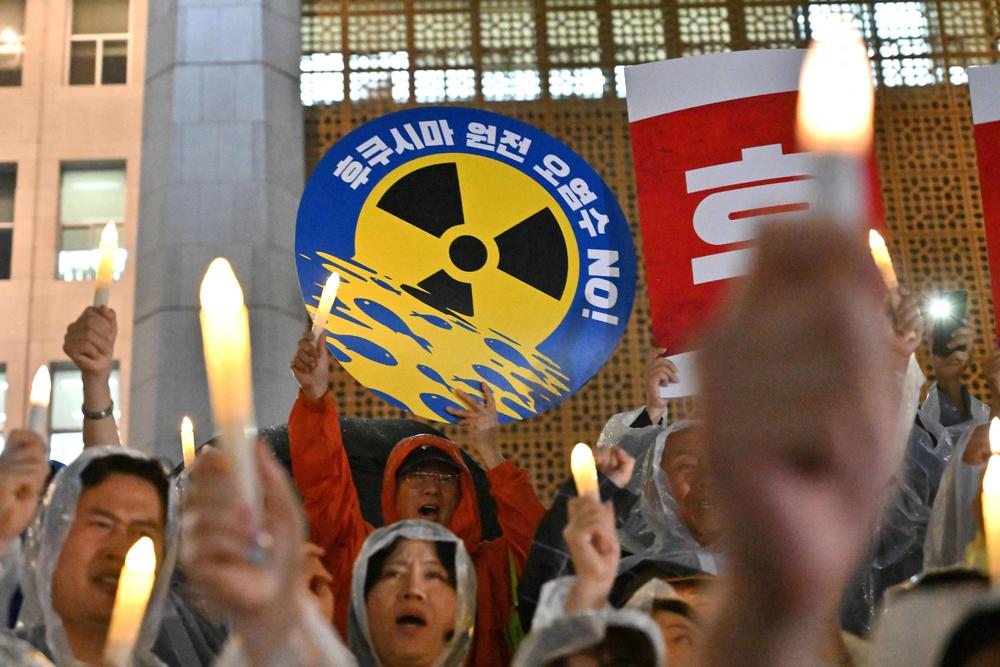Section Branding
Header Content
5 things to know about Japan's Fukushima water release in the Pacific
Primary Content
Workers in Japan have started releasing treated radioactive water from the Fukushima Daiichi nuclear power plant into the Pacific Ocean. The plant was destroyed in a 2011 earthquake and massive tsunami, and water has been accumulating ever since.
On Thursday, the Chinese government announced it was immediately suspending aquatic imports, such as seafood, from Japan.
A review by the U.N.'s nuclear watchdog says the discharge will have a negligible radiological impact to people and the environment, but some nations remain concerned. Here's what the Japanese government is doing, and why.
Why is there water at the Fukushima plant?
After the 2011 Tohoku earthquake and tsunami, several reactors melted down at the Fukushima Daiichi nuclear power plant. To avert further disaster, workers flooded the reactors with water, and that water quickly became highly contaminated. The plant is now offline and the reactors are defunct, but they still need to be cooled, which is why wastewater continues to accumulate. In the years since the accident, groundwater has also filtered into the site, and some of it has become contaminated as well.
Dealing with all this radioactive water has been a huge technical challenge for the Japanese government. Currently, some 350 million gallons are being stored in more than 1,000 tanks on-site, according to Japanese authorities. The tanks are nearing capacity and the site can't fit any more, so some of the water needs to be released, according to the government.
Can't they just filter the radioactive particles out of the water?
The government has been working on a complex filtration system that removes most of the radioactive isotopes from the water. Known as the Advanced Liquid Processing System (or ALPS, for short), it can remove several different radioactive contaminants from the water.
The authorities have used ALPS and other systems to remove some of the most hazardous isotopes, like cesium-137 and strontium-90.
But there's a radioactive isotope that they cannot filter out: tritium. Tritium is an isotope of hydrogen, and hydrogen is part of the water itself (H20). So it is impossible to create a filter that could remove the tritium.
So how does the Japanese government plan to release this water safely?
There are a couple of parts to the plan. First, they are going to dilute the water with seawater, so that there's a lot less tritium in every drop. The government says they will bring tritium levels well below all safety limits, and below the level released by some operating nuclear plants. Second, they're taking that diluted water and passing it through a tunnel under the seafloor to a point off the coast of Fukushima in the Pacific Ocean. That will dilute it further.
Finally, they are going to do this slowly. It will take decades to empty all these tanks.
Do others think this process is safe?
The Japanese government maintains that, especially when compared to some of the other radioactive material at the site, tritium isn't all that bad. Its radioactive decay is relatively weak, and because it's part of water, it actually moves through biological organisms rather quickly. And its half-life is 12 years, so unlike elements such as uranium-235, which has a half-life of 700 million years, it won't be in the environment all that long.
Given all that, the government believes that this is the safest option available.
The International Atomic Energy Agency has peer-reviewed this plan and believes it is consistent with international safety standards. The IAEA also plans to conduct independent monitoring to make sure the discharge is done safely.
"The risk is really, really, really low. And I would call it not a risk at all," says Jim Smith, a professor of environmental science at the University of Portsmouth. He's spent the past few decades studying radioactivity in waterways after nuclear accidents, including at Chernobyl.
"We've got to put radiation in perspective, and the plant release — if it's done properly — then the doses that people get and the doses that the ecosystem get just won't be significant, in my opinion," Smith says.
Edwin Lyman is the director of nuclear power safety at the Union of Concerned Scientists in Washington, D.C. He says that out of the limited options Japan has for this wastewater, none of them are good, but: "In my view, I think that their current plan, unfortunately is probably the least bad of a bunch of bad options," he says.
"The idea of deliberately discharging hazardous substances into the environment, into the ocean is repugnant," Lyman says. "But unfortunately, if you do look at it from the technical perspective, it's hard to argue that the impacts of this discharge would be worse than those that are occurring at nuclear power plants that are operating worldwide."
But not everyone agrees that discharging the water is the best option. Ken Buesseler, a senior scientist at the Woods Hole Oceanographic Institution, thinks it would have been better to keep the contaminated water on land, "where it's much easier to monitor." Options could have included mixing it into concrete to immobilize it.
Buesseler doesn't think the water will pose a risk across the Pacific. "We don't expect to see widespread direct health effects, either on humans or on marine life," he says. But he does think that non-tritium contaminates missed by the ALPS system could build up over time near the shore.
"Nearshore in Japan could be affected in the long term because of accumulation of non-tritium forms of radioactivity," he says. That could ultimately hurt fisheries in the area.
And Buesseler worries about the message sent to other nations that may be eager to dispose of nuclear waste at sea.
How are other nations responding to Japan's decision?
Other nations have expressed concern over Japan's plan. South Korea has seen mounting public protests over the decision.
Buesseler consults for the Pacific Islands Forum, a coalition of nations including the Marshall Islands and Tahiti that are also apprehensive about Japan's decision. He notes that many of these countries were subjected to high levels of radioactive fallout as a result of atmospheric nuclear tests during the Cold War. "There are islands they can't return to...because of legacy contamination," Buesseler says.
Moreover, "they're suffering in many ways from climate change and sea level rise more than the rest of the world," he says. From their perspective, Japan's release into the Pacific "is just one insult, environmentally, among others."
Copyright 2023 NPR. To see more, visit https://www.npr.org.



